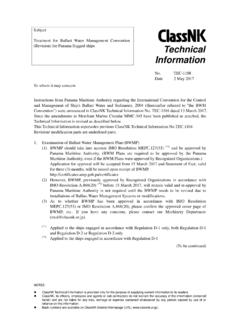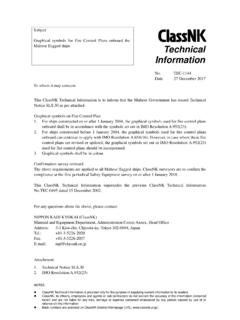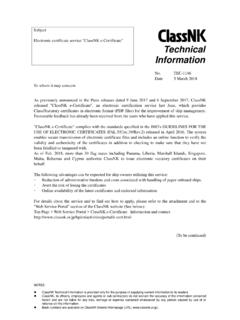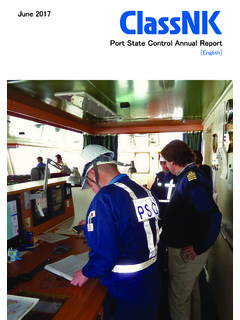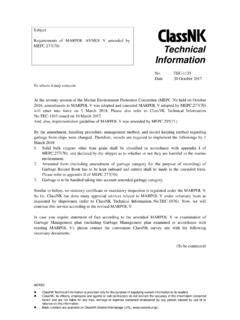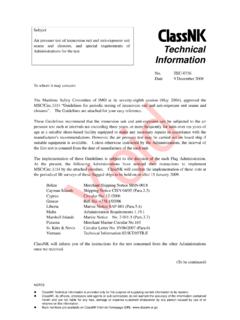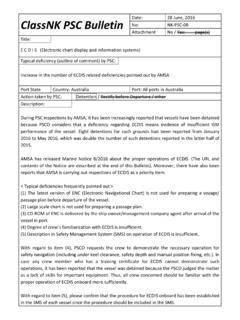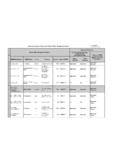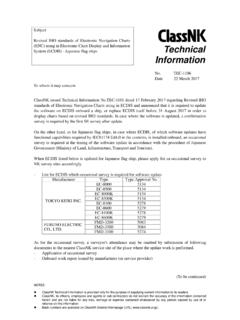Transcription of GUIDANCE OF CONTINUOUS MACHINERY SURVEY (CMS) …
1 GUIDANCE OF CONTINUOUS MACHINERY SURVEY (CMS) ( ) January 2013 NIPPON KAIJI KYOKAI GUIDANCE of CMS 1 CONTENTS I. GUIDANCE OF CONTINUOUS MACHINERY SURVEY (CMS) 1. Scope .. 2 2. Application .. 2 3. Application Procedures .. 4 4. CMS Schedule .. 5 5. Kind of SURVEY required t for credit : 5-1) Open-up inspection under Surveyor s Attendance (X) .. 5 5-2) Confirmatory SURVEY (E) .. 5 5-3) Substitution for Open-up Inspection (G) .. 7 6. Cancellation of CMS System .. 7 II. APPENDIX A. Form of Application for CMS .. 8 B. Form of CMS Schedule (Sample Plan) .. 9 C. Form of Chief Engineer s Report .. 11 D. CMS Reference Table .. 13 GUIDANCE of CMS 2 I. GUIDANCE OF CONTINUOUS MACHINERY SURVEY (CMS) 1.
2 Scope: The CONTINUOUS MACHINERY SURVEY (CMS) System is to aim to grasp the general condition of the whole MACHINERY and equipment by opening up a part of the MACHINERY and equipment through reasonable procedures in a continuously and systematically planned manner. This, of course, can only be achieved when the attending Surveyor is provided with accurate information on the ship s side (Ship-Owner or Ship Management Company, here-in-after to call Shipping Company ) maintenance at every occasion of CMS. The points of CMS system are as follows: (1) The SURVEY items of CMS specified in Chapt. 9, Part B of the Rules may be overhauled and examined according to the ship s maintenance schedule in such a manner that all of them are opened up for SURVEY once within a cycle not exceeding 5-year period.
3 (2) Conditions of those items of MACHINERY and equipment which have not been opened up at the SURVEY are evaluated from the results of the open-up inspection of the similar MACHINERY and equipment together with the records of the systematic inspection scheme in line with the ship s maintenance schedule. This system may prove a preventive measure to avoid possible damage in the future for those items of MACHINERY and equipment which have not been opened at the SURVEY , and thus can cooperate with the ship s maintenance work without disturbance of planned maintenance schedule. (3) If any defects are found on MACHINERY , equipment or parts which have been opened up in the course of CMS open-up SURVEY on similar MACHINERY , equipment or parts may be required by the attending Surveyor.
4 2. Application: The CMS system applies to those items of MACHINERY and equipment of well experienced type. The following MACHINERY and equipment are applicable to CMS system. Main Propulsion MACHINERY : (a) Steam Turbines: Turbine Rotors accompanied with Bearings, Casings Couplings between Turbine and Reduction Gears Nozzle Valves Maneuvering Valves (b) Diesel Engines: Cylinder Covers Cylinder Liners Pistons (Piston Pins and Piston Rods to be accompanied) Crosshead Pins and their Bearings Connecting Rods Crank Pins and their Bearings Crank Journals and their Bearings Camshafts and their Driving Gears Turbo-Chargers Auxiliary Blowers Air Inter-Coolers Attached essential Pumps & Coolers ( Bilge Pumps/ Pumps/ Cooling Water Cooler/CFW Cooler Hyd.)
5 Oil Pumps for Electric Control System) Power transmission system and Main Shafting: Reduction/Reversing Gears Flexible Couplings (Rubber/Fluid/Claw) Clutch Thrust Shafts and Bearings Intermediate Shafts and Bearings Auxiliary engines: Main and Aux. Generator Engines including Port-use Generator Engine Emergency Generator Engines Other Engines used for essential Auxiliaries GUIDANCE of CMS 3 Air Compressors, Blowers: Main and Aux. Starting Air Compressors (excluding those for Emergency use) Air Compressors for Control System Forced Draft Fans for Boiler (excluding the same for Boilers with a maximum evaporation of 3 tons/h or less) Cooling Water Pumps: Circulating Pumps for Main Steam Turbine Jacket Pumps Piston Oil Pumps Oil Pumps Turbo-Charger Pumps Main Pumps Pumps for Coolers Pumps for Generator Service Pumps Air Coolers Pumps Pumps: Supply Pumps Service Pumps Transfer Pumps Circulating Pumps Boiler Burning Pumps (excluding those for Boilers with a maximum evaporation of 3 tons/h or less) Lubricating Oil Pumps.
6 Pumps for Main engine Pumps for Camshaft Pumps for Reduction Gear Pumps for Controllable Pitch Propeller ( ) Stern Tube Pumps (excluding the case where Stern Tube system by natural circulation in an emergency case is also available) Thermal Oil Circulating Pumps Exhaust Value Operation oil Pumps Rocker arm Pumps Crosshead Pumps System Oil Pumps (Pumps for feeding oil to Hydraulic systems for Control and adjustment of essential auxiliaries for propulsion) Feed Water Pumps, Condensate Pumps, Drain Pumps: Feed Water Pumps Boiler Water Circulating Pumps Condensate Pumps (for Main Turbines Generator Turbines Cargo Oil Pump Turbines Ballast Pump Turbines) Dain Pumps Bilge Pumps, Ballast Pumps, Fire Pumps: Bilge Pumps (excluding those for Oily Bilge & Oily Water Separators) Ballast Pumps Pumps Fire Pumps (excluding Emergency Fire Pump) Condensers, Feed Water Heaters: Main condensers Aux.
7 Condensers Gland Condensers Atmospheric Condensers Dirty Steam Condensers Vent Condensers Drain Coolers Feed Water Heaters Deaerators Coolers: Main Coolers (for Cylinder Jackets and Pistons) Oil Coolers Coolers for Turbo-Chargers Coolers for Generator Engines Main Coolers Turbo-Charger Coolers Camshaft Coolers Reduction Gear Coolers Control Oil Coolers Coolers for Stern Tube Coolers Coolers for Generator Turbines Air Coolers Coolers Coolers Oil Heaters: Heaters and Heaters (excluding Electric Heaters having a capacity of 10 kw or less) Tanks (having a capacity of more than 1m3 which do not form part of the Ship s Hull Structure) Settling Tanks and Service Tanks (for Main and Auxiliary Engines) Tanks for Boilers Air Reservoirs (For Main Auxiliary Control Emergency) Cargo Oil Pumping Installation: Cargo Oil Pumps (including Chemical, Liquid Gas Pumps) Stripping Pumps Tank Cleaning Pumps Tank Cleaning Heaters and Drain Coolers Drain Coolers for Cargo Oil Heaters GUIDANCE of CMS 4 Deck MACHINERY .
8 Steering Gears Windlass Mooring Winches (including their Hydraulic Oil Pumps) Fresh Water Generator (for Main Boiler Water to use for driving Steam Turbines) Cargo Refrigerating Installation: Compressors Condenser Pumps Primary Refrigerant Pumps Brine Pumps Condensers Evaporators Other items of MACHINERY , Equipment and Refrigerating Installations which the Society considers to be covered by CMS 3. Application Procedures: (1) Where the CMS system is applied, the procedures are as follows: New Ships: (a) One copy each of the forms of Application for CMS and CMS Schedule (as shown in Appendix A and B respectively) and, if necessary, this GUIDANCE will be sent to the Shipping Company (Ship-Owner or Ship Management Company) from the Head Office in about 3 months after completion of the Classification SURVEY .
9 (b) The Shipping Company should submit each one (1) copy of the Application for CMS filled with necessary information, and CMS Schedule to Classification Department of Head Office or the Local SURVEY Office prior to the first CMS SURVEY . (c) Two(2) copies (one(1) for the Shipping Company and one(1) for the Ship s file) will be returned to the applicant with following endorsement on the Application for CMS , signed by General Manger of Classification Department or the SURVEY Office. Accepted the application for CONTINUOUS MACHINERY SURVEY System to the ship . (Port) (Date) (Signature) Name Title Existing Ship (in such case as the ship class-transferred from other classification society): (a) The SURVEY items applicable to CMS are newly registered by the Society referring to the record of CMS SURVEY carried out by the previous Society.
10 (b) The due date of each CMS item shall be taken over that of previous Classification Society. (c) In case CMS system was not applied in previous class, 5 years SURVEY cycle shall be started from the delivery date of new-shipbuilding or the latest Special SURVEY at previous class whichever comes later. (d) Where all CMS items were surveyed at the class-transfer SURVEY , the application procedures may be made same manner as above foe new ship. (2) It is a usual way that an application for CMS is submitted within about 3 months after the construction SURVEY or class-transfer SURVEY but this application may be acceptable at any time. GUIDANCE of CMS 5 4. CMS Schedule: (1) Details of CMS Schedule The CMS Schedule should be prepared referring to the items to below and be kept on board the ship for reference to the attending Surveyor.
